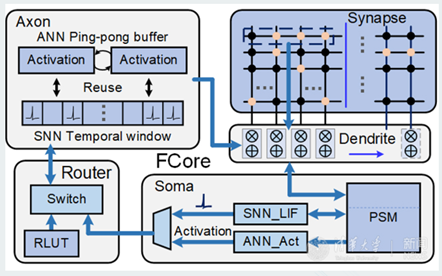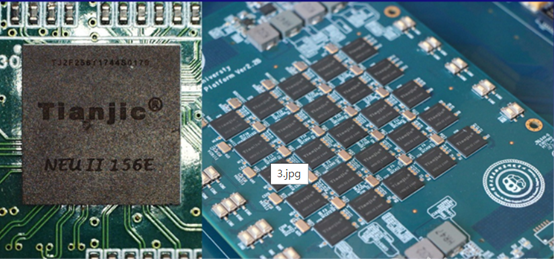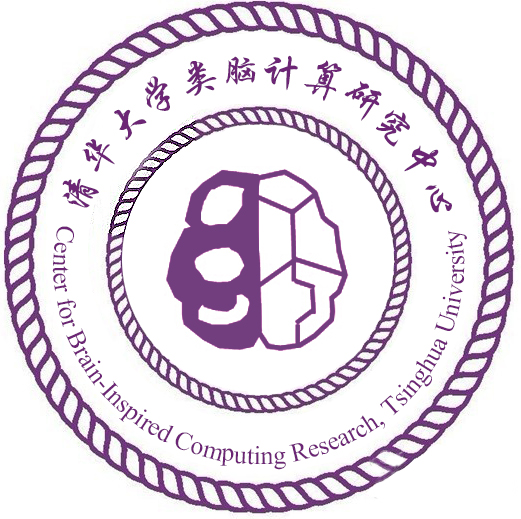Recently the team led by Professor Luping Shi in the Center for Brain-Inspired Computing Research, in the Department of Precision Instrument, published an important research result — Tianjic, a novel brain-inspired computing chip. This chip is the world’s first hybrid-paradigm chip for brain-inspired computing to facilitate the development of artificial general intelligence (AGI). On the research results, the paper “Towards artificial general intelligence with hybrid Tianjic chip architecture” was published as a cover article in the 1st August edition of the journal “Nature”. This also achieved a breakthrough in the publication of a paper in Nature by a Chinese team in the field of artificial intelligence and chips.

Figure 1: Architecture overview of the hybrid-paradigm Tianjic chip
The rapid development of artificial intelligence technologies has enabled people to achieve unprecedented breakthroughs in many fields. However, current mainstream artificial intelligence technology is task-specific, which faces great limitations. AGI is a promising direction which can be applied in all areas, but so far there has been no effective solution. In general, the development of AGI mainly has two approaches: computer-science-oriented and neuroscience-oriented. Both have their own advantages and disadvantages. At present, the integration of these two approaches is believed to be one of the most promising solutions towards AGI, while an efficient hardware platform that supports the hybrid-paradigm computing is its important cornerstone.

Figure 2: The single Tianjic chip (left) and a board with 5×5 chip array (right).
Based on the computing principles of brain science, the CBICR team proposes a novel brain-inspired computing architecture, a hybrid-paradigm Tianjic chip, which can simultaneously support computer-science-oriented and neuroscience-oriented neural networks and leverage their strengths, such as artificial neural networks and spiking neural networks. On the basis of the first-generation chip developed in 2015, the second-generation Tianjic chip was released in 2017. After continuous design improvement, the current Tianjic achieves flexible functionality, high speed, and low power. Compared to the TrueNorth chip at IBM, Tianjic provides more comprehensive functionality, better flexibility/scalability, 20% higher density, ten times higher speed, and 100 times higher internal bandwidth. Furthermore, the team has also developed the first-generation software tool chain that supports automatic model mapping and compiling.
An unmanned bicycle was constructed as a versatile and scalable AGI developing platform, on which they demonstrated rich functionalities using one chip for areas such as speech recognition, object detection and tracking, balance control, obstacle avoidance, and decision making. This work provides a new direction and platform for academia to conduct research on AGI, which will facilitate the development of the AGI and impact on industry.

Figure 3: The demo platform of a self-driving bicycle.
The co-first authors of this paper are Jing Pei (Associate Research Fellow at the Department of Precision Instrument, Tsinghua University), Lei Deng (previous Ph.D. at Department of Precision Instrument, Tsinghua University; currently postdoctoral Fellow at the Department of Electrical and Computer Engineering, University of California at Santa Barbara), Sen Song (Associate Professor at the Department of Biomedical Engineering, Tsinghua University), Mingguo Zhao (Associate Research Fellow at the Department of Automation, Tsinghua University), Youhui Zhang (Professor at the Department of Computer Science, Tsinghua University), Shuang Wu and Guanrui Wang (Ph.D. candidates at the Department of Precision Instrument, Tsinghua University). The corresponding author is Luping Shi (Professor at the Department of Precision Instrument, Tsinghua University). The first affiliation is Tsinghua University, and the collaborative affiliations include Beijing Lynxi Technologies, Beijing Normal University, Singapore University of Technology and Design, and the University of California at Santa Barbara.
Paper link:https://nature.com/articles/s41586-019-1424-8
(Source: Tsinghua University)

